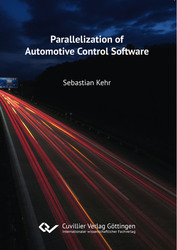| Departments | |
|---|---|
| Book Series (96) |
1378
|
| Nachhaltigkeit |
3
|
| Gesundheitswesen |
1
|
| Humanities |
2364
|
| Natural Sciences |
5406
|
| Mathematics | 229 |
| Informatics | 319 |
| Physics | 980 |
| Chemistry | 1363 |
| Geosciences | 131 |
| Human medicine | 243 |
| Stomatology | 10 |
| Veterinary medicine | 108 |
| Pharmacy | 147 |
| Biology | 835 |
| Biochemistry, molecular biology, gene technology | 121 |
| Biophysics | 25 |
| Domestic and nutritional science | 45 |
| Agricultural science | 1004 |
| Forest science | 201 |
| Horticultural science | 20 |
| Environmental research, ecology and landscape conservation | 148 |
| Engineering |
1793
|
| Common |
98
|
|
Leitlinien Unfallchirurgie
5. Auflage bestellen |
|
Advanced Search
Parallelization of Automotive Control Software (English shop)
Sebastian Kehr (Author)Preview
Table of Contents, PDF (45 KB)
Extract, PDF (160 KB)
Automotive control software is developed according to the AUTomotive Open System ARchitecture (AUTOSAR) standard. High development costs require the re-use of existing software when the hardware platform changes from a single-core to a multicore electronic control unit (ECU).
This Ph.D. thesis focuses on the migration of AUTOSAR legacy software to a multicore ECU. Different parallelization methods are proposed and evaluated; RunPar and Supertasks on runnable-level, timed implicit communication on task-level, and the parallel schedule quality metric for quantification of combinations. The methods respect data dependencies and still enable parallel execution, they exploit the energy-saving potential of the processor, they guarantee latency constraints, and they reproduce the reference data-flow.
| ISBN-13 (Hard Copy) | 9783736994317 |
| ISBN-13 (eBook) | 9783736984318 |
| Final Book Format | A5 |
| Language | English |
| Page Number | 220 |
| Edition | 1. Aufl. |
| Publication Place | Göttingen |
| Place of Dissertation | Ilmenau |
| Publication Date | 2016-12-20 |
| General Categorization | Dissertation |
| Departments |
Informatics
|
| Keywords | Automotive control software, AUTomotive Open System ARchitecture (AUTOSAR), data-flow |








